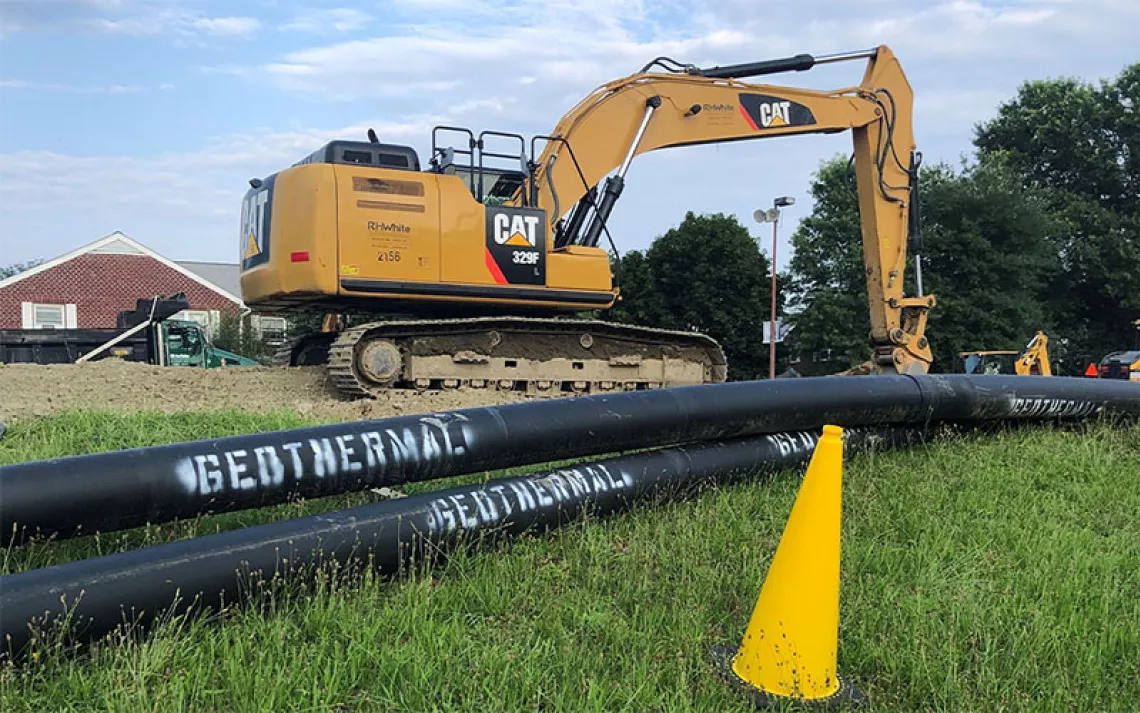Japan's Choice
Rich geothermal resources could replace much of Japan's shuttered nuclear power--but at the risk of spoiling its treasured onsen
Hot, mineral-rich water gurgles from a fountain into a long pool at Choyotei Hotel in Hokkaido, Japan. Steam wisps above the water and beads on the floor-to-ceiling windows, through which bathers gaze out at a dramatic river gorge and the forested mountains of Daisetsuzan National Park. Dozens of Japanese women slip off their cotton robes and slide naked into the water. A cluster of elderly women whisper in one corner; in another, a tired mother leans her head back and dissolves into relaxation.
This hotel, like many others in the area, is dedicated to the ritualistic enjoyment of onsen, the natural hot springs that have been beloved throughout Japan for more than a millennium. Anything that might imperil this rich bathing tradition is viewed with deep suspicion--and that includes the development of clean, dependable geothermal power in a country desperate for new sources of energy.
It's been three years since a tsunami rolled through Japan's Fukushima Daiichi nuclear power plant, knocking out power and causing three reactor cores to melt down. More than 100,000 people fled their homes as a radioactive plume drifted across northeast Japan, and many towns near the plant remain empty. (See "Grapple," page 27.) In the disaster's aftermath, the Japanese government shut all of the country's reactors (which supplied 30 percent of the nation's electricity), replacing nuclear with oil, coal, and natural gas. To reduce the carbon intensity of this energy mix, the government is also trying to expand the country's small renewable energy sector.
"We have big hope for geothermal," says Hirofumi Tani, chief of general affairs in Kamikawa, a tiny town nestled at the foot of the mountains outside Daisetsuzan. Japan has the third-highest number of geothermal reservoirs in the world (after the United States and Indonesia), and geothermal power plants could provide up to 20 gigawatts of constant electricity, unlike the variable power from solar and wind. That's nearly half of the generating capacity once provided by all of Japan's nuclear facilities.
Kamikawa officials have tried since the 1960s to develop the region's rich geothermal resources--so far without success. The town exemplifies the promise and pitfalls of Japanese geothermal development. Almost all of the country's subterranean reservoirs of hot water and steam are located in national parks. Many parks, like Daisetsuzan, feature charming hot spring hotels in unspoiled forests where vacationers come to relax. Geothermal plants, with their pipes and pumps and electric lines, would sully the idyllic picture.
In the Kamikawa town office, as cuckoos call in the trees outside the open window, Tani recounts the history of the municipality's attempts to create a geothermal plant in harmony with the natural world. Back in 1968, after town engineers had won permission to drill exploratory holes in a promising location within Daisetsuzan, they quickly tapped a rich reservoir. Tani proudly shows photos of thick jets of steam billowing from the deep green forest and shooting from pipes in the ground. But the effort came to an end in 1972, when the central government banned new geothermal development in national parks.
In the ensuing decades, Japan focused on nuclear plants, while renewable projects languished. The country has only 18 geothermal plants, which together account for less than 1 percent of national electricity generation. "We endured a winter season in geothermal," says Masaho Adachi, steering committee chair of the Japan Geothermal Association, "but after Fukushima, the conditions changed." In the wake of the disaster, federal legislators opened certain parts of national parks to geothermal development and allocated $200 million to help private companies explore new projects.
In Daisetsuzan, the giant Marubeni Corporation is now investigating those sites that the Kamikawa engineers found promising in the 1960s. Adachi notes that the new law specifies that any geothermal plant built in a park must be yuryo jirei, an "excellent case." The phrase is a little problematic, Adachi says with an exasperated laugh, "because no one knows what is an excellent case." Any plant will have to be aesthetically pleasing and discreet, he says, and should be screened from roads and public vistas. "If it's impossible to hide it entirely, we have to modify or camouflage it," he says. "Conservationists don't want to see any artificial buildings in nature."
Supposing geothermal plants built inside national parks could be blended seamlessly into the beech trees, hotel owners still worry that tapping deep geothermal reservoirs will interfere with their shallower hot springs, reducing the temperature or volume of the water that their clients treasure.
"Even if you don't see the impact on the surface, who knows what happens underground," says Hirokazu Nunoyama, secretary general of the Japanese Spa Association, sitting beneath a poster showing an exquisite natural hot spring ringed with snow. "Once you see the problem, it's too late."
There are more than 13,000 hot spring hotels operating around the country, Nunoyama says, and their owners' concerns must be heard. They want independent assessment of the possible impacts of each project, ongoing environmental monitoring, and compensation for any loss of business. The Spa Association understands that some sacrifices may be necessary to keep the lights on in post-Fukushima Japan, Nunoyama says, but he doesn't want hotel owners to bear too much of the burden. "It's not that we are against anything and everything," he says. "Just disorderly development."
The Japanese Geothermal Association says that concerns over geothermal plants sapping hot springs of their potency are overblown and reflect an ignorance of geology and hydrology. "Onsen people," Adachi says, "have no idea about underground geological conditions." In most cases, he says, Japan's deep geothermal reservoirs (usually more than a mile below the surface) are not directly connected to the shallow hot springs that bathers enjoy. This can be proved, he says, by comparing the composition of the water in the two locations to confirm that the reservoir is not the source of the spring.
There may be a technological compromise to Japan's conundrum, says Karl Gawell, executive director of the U.S. Geothermal Energy Association. Geothermal plants are usually big industrial facilities that use steam to turn turbines, producing power in the 100-megawatt range. Japan, he says, may be better suited to smaller "binary" plants, where steam travels through a heat exchanger to boil a fluid with a low boiling point like butane, whose gas spins the turbine. The water vapor is then pumped back down into the ground, Gawell says, "so sustainability of the reservoir is not as much of an issue."
In addition, binary plants typically produce only about 20 megawatts of power and have lower physical profiles. "There are plants in Reno that are within city limits," Gawell says. "People drive by them every day and don't know what they are."
Still, it's one thing to disguise a power plant on the industrial outskirts of Reno and quite another to conceal one in the green mountains of Daisetsuzan National Park. Back in the Choyotei Hotel's hot pools, bathers nervous about future vacations can take solace in the fact that in Japan, where caution reigns, nothing is likely to be done hastily. Hirofumi Tani of Kamikawa says that it could take 10 years to work through all the required environmental assessments and actually build a power plant in the vicinity. That means many more years for hotel guests to relax in the steaming water while gazing through the windows at serene, untouched mountainsides.
As they soak, however, they might contemplate their priorities for post-Fukushima Japan. In a recent poll, nearly 60 percent of respondents disagreed with the current government's plan to revive nuclear energy. Yet because of the closure of the country's nuclear plants, the government has dramatically slashed its goals for reducing carbon dioxide emissions by 2020. If Japan is to steer a course between nuclear energy and climate change, sharing its treasured onsenmay have to be part of the mix.
The American Way Like the Japanese, Americans aren't very enthusiastic about geothermal plants in national parks. Our park system began as an effort to protect the awe-inspiring geysers of Yellowstone, and drilling for geothermal energy (or anything else) in parks is strictly forbidden. In the 1990s, a religious group that owned a large ranch on Yellowstone's northern border opened one geothermal well and discussed drilling more, raising alarms about their effect on Old Faithful and other geysers. The dispute ended with the federal government agreeing to buy the group's geothermal resources for $13 million.
Parks aside, half the geothermal power in the United States today comes from plants located on federal lands. Last August, Secretary of the Interior Sally Jewell announced a goal of approving 20,000 megawatts of clean energy projects, including geothermal, by 2020. She pointed to two proposed geothermal projects on Bureau of Land Management land in California--one of which, in the Imperial Valley, could help fill in for the shuttered San Onofre Nuclear Generating Station.
As with any major industrial project, siting is a key issue. While strongly in support of clean energy, the Sierra Club opposes geothermal projects that might affect geysers, hot springs, or other exceptional natural features, and flatly opposes developments in or near parks or sites of cultural or archaeological value. Bruce Hamilton, the Club's deputy executive director, points to the geyser fields at Beowawe and Steamboat Springs in Nevada that were destroyed by geothermal development. "There are lots of ways you can get clean power," he says, "without screwing things up."--E.S.
 The Magazine of The Sierra Club
The Magazine of The Sierra Club






